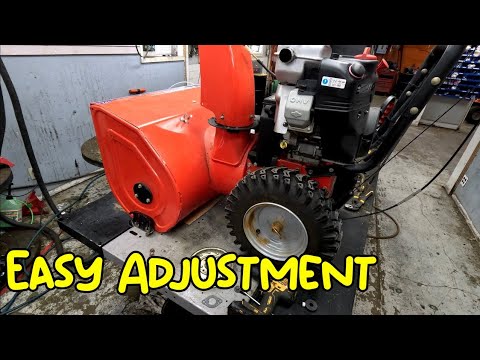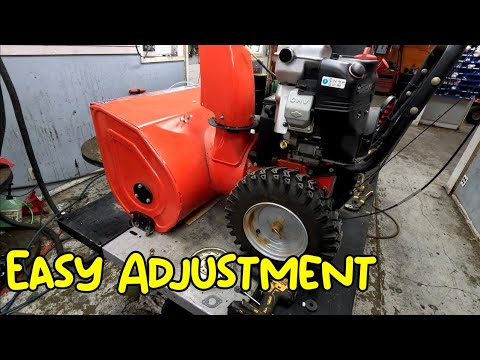Hello there! Have you ever noticed that after using your snowblower, there always seems to be a thin layer of snow left behind? We’ve experienced the same issue, and we understand how frustrating it can be. In our article, we’re going to delve into the reasons why your snowblower might be leaving behind that stubborn layer of snow.
Curious to find out more? We’ve got you covered! In the article, we’ll be exploring various factors that could contribute to this problem, such as the type of snow you’re dealing with, the condition of your snowblower’s blades, and even the way you’re operating the machine. Understanding these factors will not only help you figure out why your snowblower is leaving a layer of snow, but it will also guide you in finding effective solutions. So, sit tight and get ready to learn more in our detailed article on this topic! Winter can be a beautiful season, with snow-covered landscapes and cozy fires. However, when it comes to clearing snow, it can be a frustrating and time-consuming task. Snowblowers are a convenient and efficient way to remove snow from driveways, sidewalks, and other areas. However, there are times when even the best snowblowers leave a layer of snow behind. In this article, we will explore the common causes of this issue and offer helpful tips to ensure that your snowblower clears the snow effectively.
Snowblower Speed and Gear Setting
The speed and gear setting of your snowblower play a crucial role in its ability to remove snow effectively. If you set the speed too low, the snowblower may struggle to throw the snow far enough, resulting in a layer of snow being left behind. On the other hand, setting the speed too high can cause the snow to be blown up and over the discharge chute, resulting in a messy and inefficient clearing process.
To avoid this issue, it is important to find the right balance between speed and gear setting. Experiment with different speed and gear combinations to find what works best for your snowblower and the type of snow you are removing. Remember, every snowblower is different, so it may take some trial and error to find the perfect setting.
Snowblower Depth Adjustment
Another common cause of snowblowers leaving a layer of snow is improper depth adjustment. The depth adjustment on a snowblower determines how close the auger is to the ground, and therefore, how much snow it can effectively remove. If the depth adjustment is set too high, the snowblower will not be able to clear the snow down to the surface, resulting in a layer of snow being left behind.
To ensure proper snowblower depth adjustment, check the position of the skid shoes and the scraper bar. The skid shoes should be adjusted so that they are just barely touching the ground, while the scraper bar should be set so that it is level with the surface. By properly adjusting these components, you can ensure that your snowblower removes the snow right down to the ground, leaving no layer of snow behind.
This image is property of qph.cf2.quoracdn.net.
Wet and Heavy Snow Conditions
Snow conditions can greatly impact the performance of your snowblower. Wet and heavy snow, in particular, can be challenging to clear, as it can clog the snowblower’s chute and impede the auger’s rotation. When the snowblower struggles to process the snow effectively, it may leave a layer of snow behind.
To tackle wet and heavy snow effectively, it is important to understand its impact on your snowblower’s performance. Wet snow is denser and has more moisture content, making it more challenging to throw. In such conditions, it may be necessary to slow down the snowblower’s speed and adjust the gear setting accordingly. Additionally, clearing wet snow in smaller sections can help prevent overloading the snowblower and ensure a more thorough clearing.
Snowblower Auger Condition
The condition of the snowblower’s auger can also affect its ability to clear snow effectively. If the auger is worn or damaged, it may not be able to grab and throw the snow properly, resulting in a layer of snow being left behind. Additionally, if the auger fails to rotate or rotates unevenly, it can hinder the snowblower’s performance.
Regular maintenance and inspection of the auger are essential to prevent these issues. Inspect the auger blades for any signs of wear or damage, such as cracks or chips. Replace any worn or damaged blades to ensure optimal performance. Additionally, ensure that the auger rotates smoothly and evenly by lubricating the necessary parts and removing any debris that may be causing obstruction.

This image is property of www.rcpw.com.
Insufficient Clearing Width
The clearing width of your snowblower is another factor that can contribute to the presence of a layer of snow after clearing. If your snowblower has a narrow clearing width, it may take more passes to clear a given area, potentially leaving patches of snow behind.
Consider the size of the area you need to clear when choosing a snowblower. Ensure that the clearing width is sufficient to cover the area efficiently, minimizing the need for multiple passes. Investing in a snowblower with a wider clearing width can significantly improve the overall clearing performance and reduce the likelihood of leaving a layer of snow behind.
Improper Snowblower Technique
Snowblowing may seem like a straightforward task, but improper technique can also contribute to a layer of snow being left behind. There are several common mistakes that snowblower users make, including blowing the snow in the wrong direction, failing to overlap passes, and maintaining inconsistent snowblower speed.
When clearing snow, it is essential to blow it in the correct direction. Avoid blowing the snow back onto areas that have already been cleared, as this can lead to a layer of snow being left behind. Instead, direct the snow away from the cleared areas to ensure an even and thorough clearing.
Overlapping passes is another important technique to prevent leaving a layer of snow. By overlapping each pass slightly, you ensure that no areas are missed and that the snow is cleared evenly. Take your time and be mindful of the overlap to ensure a thorough snow removal.
Maintaining a consistent snowblower speed is also crucial for effective snow clearing. Rapid speed changes can result in uneven snow removal and leave a layer of snow behind. Find a comfortable pace that allows the snowblower to effectively process and throw the snow without overwhelming its capabilities.

This image is property of i.ytimg.com.
Conclusion
In conclusion, there are several common causes of snowblowers leaving a layer of snow behind. These include improper speed and gear setting, incorrect depth adjustment, wet and heavy snow conditions, auger condition, insufficient clearing width, and improper snowblower technique. By understanding these factors and implementing the necessary adjustments and techniques, you can ensure that your snowblower clears snow effectively and leaves no layer of snow behind.
It is essential to take the time to properly set up and maintain your snowblower, as well as develop the right technique for clearing snow. Investing in a quality snowblower with the appropriate features, such as adjustable speed and clearing width, can also greatly improve its performance. By following these tips and being mindful of the conditions and techniques involved in snowblowing, you can enjoy a snow-free driveway and walkways all winter long. Stay safe and happy snowblowing!
